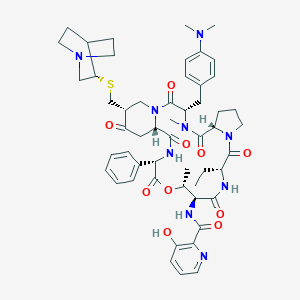Details of the Drug
General Information of Drug (ID: DMLKFC4)
| Drug Name |
Quinupristin
|
||||||||||||||||||||||
|---|---|---|---|---|---|---|---|---|---|---|---|---|---|---|---|---|---|---|---|---|---|---|---|
| Synonyms |
Quinupristina; Quinupristine; Quinupristinum; SYB; RP 57669; Quinupristin [USAN:INN]; Quinupristina [INN-Spanish]; Quinupristine [INN-French]; Quinupristinum [INN-Latin]; RP-57669; Synercid (TN); Quinupristin (JAN/USAN/INN); 4-[4-(DIMETHYLAMINO)-N-METHYL-L-PHENYLALANINE]-5-[(2S,5R)-5-[[[(3S)-1-AZABICYCLO-[2.2.2]OCT-3-YL]THIO]METHYL]-4-OXO-2-PIPERIDINECARBOXYLIC ACID]VIRGINIAMYCIN; 5delta-(3-quinuclidinyl)thiomethylpristinamycin IA
|
||||||||||||||||||||||
| Indication |
|
||||||||||||||||||||||
| Therapeutic Class |
Antibiotics
|
||||||||||||||||||||||
| Drug Type |
Small molecular drug
|
||||||||||||||||||||||
| Structure |
 |
||||||||||||||||||||||
| 3D MOL is unavailable | 2D MOL | ||||||||||||||||||||||
| #Ro5 Violations (Lipinski): 2 | Molecular Weight (mw) | 1022.2 | |||||||||||||||||||||
| Logarithm of the Partition Coefficient (xlogp) | 4.2 | ||||||||||||||||||||||
| Rotatable Bond Count (rotbonds) | 10 | ||||||||||||||||||||||
| Hydrogen Bond Donor Count (hbonddonor) | 4 | ||||||||||||||||||||||
| Hydrogen Bond Acceptor Count (hbondacc) | 14 | ||||||||||||||||||||||
| ADMET Property |
|
||||||||||||||||||||||
| Chemical Identifiers |
|
||||||||||||||||||||||
| Cross-matching ID | |||||||||||||||||||||||
Molecular Interaction Atlas of This Drug
 Drug Therapeutic Target (DTT) |
|
||||||||||||||||||||||||||
|---|---|---|---|---|---|---|---|---|---|---|---|---|---|---|---|---|---|---|---|---|---|---|---|---|---|---|---|
| Molecular Interaction Atlas (MIA) | |||||||||||||||||||||||||||
References
